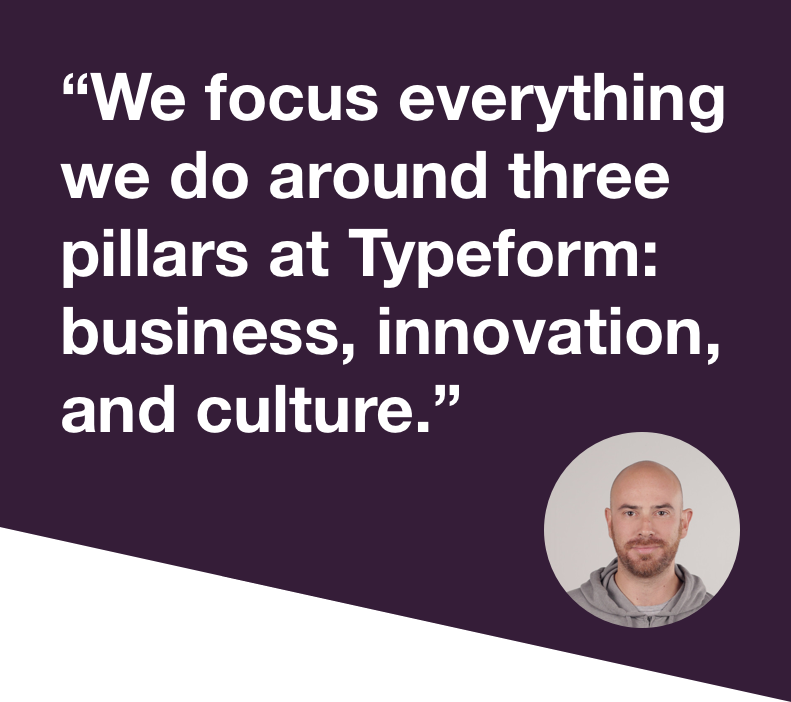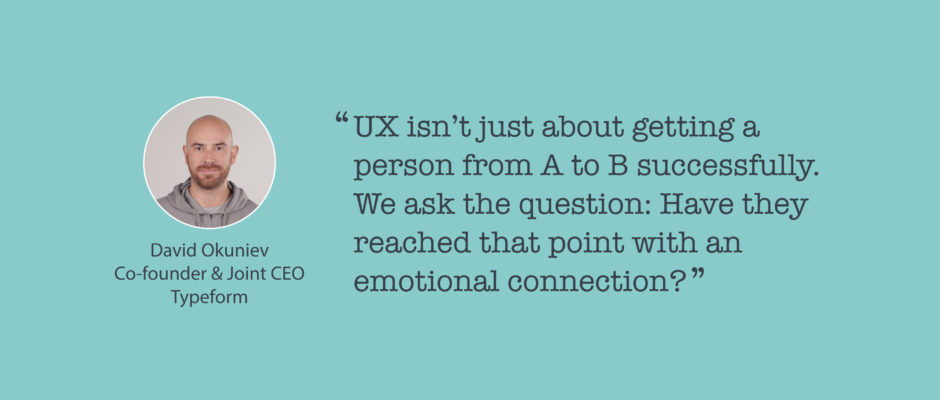You can also check out this interview on the SaaS Open Mic Podcast:
https://soundcloud.com/chartmogul/david-okuniev-typeform
A background in design
Ed: So, David, thanks for joining me today for a quick chat. I think there are some pretty interesting things that I would love to pick your brain about.
David: Yep, pleasure to be here.
Ed: You are Co-founder and Joint CEO of Typeform. Apologize to dive right into the thick of it, but your background is as a designer. And Typeform is something that evolved from something you were doing in your spare time with your co-founder Robert (Muñoz).
I was wondering if you could just go over how your background as designer has influenced Typeform as a business and how you’re building that.
David: The easiest way to think about that is — we had a problem which was that me and my co-founder had a customer that wanted to put a form in an exhibition space. So instead of just building a standard form, we wanted to do something that would really jump out at people and engage them, in order to get their data.
So, we were basically given a design problem to solve. We solved it for that particular project and based on that, everything followed.
We discovered that if you actually build a form which goes one question at a time, and has good design, then it encourages engagement. When we discovered this we thought — why don’t we build a company around that?
Vision for Typeform
Ed: What would you say is your vision for Typeform, as a product or as a business?
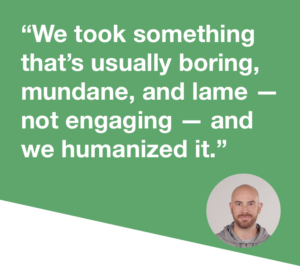
David: Quite a loaded question!
When we started off we saw ourselves as a form builder, because essentially that’s what we built: a much better form. But we quickly found out that people were using Typeform to do lots of different communication around questions and answers.
So going forward, we’re trying to move away from being perceived as a form tool and more as a communication tool. Because really Typeform does allow you to have a conversation through an interface. You can give data, and also connect data. And you can create all sorts of workflows.
So as a product vision goes, that’s where we want to focus our efforts moving forward. That’s why we’re rebuilding the platform as we stand to support that product vision.
As a company, we have a vision statement, which is:
“Make things a little more human.”
We didn’t have these words when we started, right? But that’s how it transpired. That’s actually what we did at the beginning. We took something that’s usually boring, mundane, and lame — which isn’t engaging — and we humanized it.
So as a company that’s our crying call. Always trying to make things a little more human. Humanizing the product, humanizing the way we’re building out the company as well.
Ed: Yes and I see that message conveyed all the way through, from your product to your blog and any communication that comes out of the business.
Chatbots, the hot topic
Ed: So there’s a lot of hype around conversational interfaces and messaging interaction. It’s huge. We’re seeing the rise of chatbots and things.
You guys were there before all this was happening. How do you think Typeform fits into that? Or do you fit into that?
David: It’s funny because I get asked this question a lot.
Ed: Damn.
David: It’s fair enough! It’s a good question.
Like you say, we’ve been doing it from the beginning. For us it’s a natural extension of what we do. I wouldn’t discount us allowing people to interact with Typeform through a chat application. It works pretty much the same way — it’s one question at a time.
I do think there’s a lot of hype around conversational interfaces, especially in that they’re going to replace the traditional point-and-click interfaces. The jury is still out on that. But I do see that, eventually in the future, that’s probably the way things are going to go.
I think we’re going to be less reliant on having devices and just seeing stuff in our field of view. And the best way to interact when you have no device is to actually have a conversation. So I think eventually we’ll get to that, but I don’t think it’s spelling the end of the traditional interface as we know it.
Humans > Users
Going beyond UX
Ed: I’ve seen a lot of stuff coming out of the Typeform blog, specifically around UX and trying to look beyond UX as a concept. Can you talk a little bit about what’s wrong with UX, and why we need to go beyond the way we think about user experience?
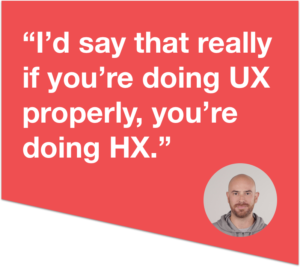 David: Well, I wouldn’t say there’s anything particularly wrong with UX. But I think, at least from our point of view, doing UX isn’t just about getting a person from A to B successfully. What we do is ask the question: Have they reached that point with an emotional connection?
David: Well, I wouldn’t say there’s anything particularly wrong with UX. But I think, at least from our point of view, doing UX isn’t just about getting a person from A to B successfully. What we do is ask the question: Have they reached that point with an emotional connection?
Because that’s really what makes people fall in love with product, if there’s that emotional connection. So if you’re just creating experiences to get people to complete objectives, then you’re actually missing out on a whole other dimension.
I think if you look at the way technology is trending, if you look at conversational UI, everything is trending to be more and more humanized. We’re trying to remove this barrier between us and the computer.
Embracing HX
Ed: So in your view, then, if there was a definition for what you would call Human Experience, what would that be?
David: Well, I’d say it’s beyond UX so it’s not thinking about users, but about humans. Real people. What are their needs? What are their emotions? It’s not just treating a user as another non-verbal commodity. It’s thinking about who the user really is. You really have to get close to them, understand them.
I just want to make clear — I don’t want UX designers and others listening to think, “Yeah well, we are doing this already.” For us it’s just the way to cement that inside our process. To make sure that we remember each time that we’re not dealing with users, we’re dealing with humans here.
Ed: In what ways do you actually implement that in your development process or your design process?
David: We do the standard UX stuff. Customer interviews, testing everything, making sure everything is working for different profiles of users. Other than that, it’s just an attitude we have to have. It’s more about setting the bar high than there being a very strict technical definition between UX and HX. HX is just a word, but word have meanings.
So it’s not necessarily about the differences in the process between UX and HX. I would say that really if you’re doing UX properly, you’re doing HX.
Data-informed > data-driven
Ed: What kind of balance do you strike between measurable metrics and quantifiable results, versus more a of a gut-feel, culture driven sense of “this is right; this makes sense for us to do”?
David: When we started Typeform, we didn’t have any data analysts or a marketing team to look at the data. Everything was done on gut feel, even as far as design went. The Typeform you see today, the actual form, that’s the result of not going through any formal UX process. It’s just the designer working out a solution for a problem.
Now we’re much more data-driven. It doesn’t mean we’re absolutely data-driven about everything. We think of ourselves as “data-informed,” because we still do make gut decisions.
Sometimes the data will tell you something, but you don’t feel comfortable actually implementing that solution. For example, you may get better conversion rates if you use darker design patterns or try to really push a user to take a certain action. But you have to ask yourself, “Is this the right thing to do?”
You have to think about how this impacts the customer’s perception of your product and, I would even say, how does it impact their perception of the employees of that product who’ve made that decision.
So it’s very much a balance. And that’s why we try to think of ourselves as data-informed.
Culture
Letting culture evolve
Ed: We love using Typeform at Chartmogul. It’s been great for our NPS surveys and other things.
One thing I’ve noticed is — and maybe this just falls into the human element — you guys seem to do an impeccable job of conveying the culture of the company through the product and your website.
Is that something that’s by design? What’s your approach to culture at Typeform? Is this something that you’ve designed specifically, or is it something that’s just evolved?
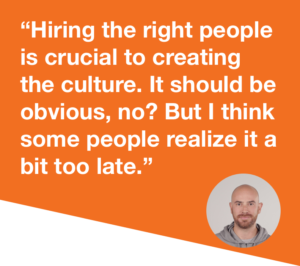 David: It’s just evolved. I mean, we do have a very strong focus on it. In fact we focus everything we do around three pillars at Typeform: business, innovation, and culture. So culture gets a very big seat at the table. But as far as us having a seated culture plan, no. It’s just came up naturally.
David: It’s just evolved. I mean, we do have a very strong focus on it. In fact we focus everything we do around three pillars at Typeform: business, innovation, and culture. So culture gets a very big seat at the table. But as far as us having a seated culture plan, no. It’s just came up naturally.
I think it’s a result of the founders but also the people that we’ve surrounded ourselves with. That’s what creates a culture. Yes, at one point we could say, “This is our culture.” But that was after it had developed somewhat so we could understand it.
Nurturing culture with the right hires
Ed: How important do you think the hiring process is as a part of that? What kind of people do you look for at Typeform, and how particular are you about hiring great people?
David: Hiring great people is super important. Otherwise you’re going to affect your culture. For example in our case, we always look for people who are humble, passionate, and smart. And if you allow people who don’t fit those qualities, then that’s going to change the culture. If you allow people who are smart and passionate, but who are really loud and egotistical, then that’s going to affect the culture.
Hiring the right people is crucial to creating the culture. It should be obvious, no? But I think some people realize it a bit too late.
Scaling culture
Ed: So you guys have been through a bunch of changes recently. How many people do you have at the offices in Barcelona now?
David: 129.
Ed: And you’ve moved to this beautiful new location now. How has Typeform grown? In scaling Typeform, have you come across any challenges or things you need to change in order to preserve the culture?
David: Yeah, this is the typical thing that happens, right? Startups grow really fast in a short period of time, and the culture is at risk.
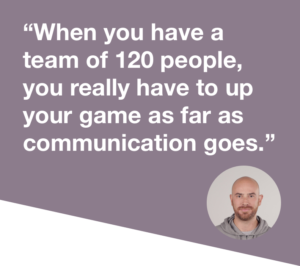 I’d say when you get over 60 or 80 people, then to keep the culture going you have to look at implementing more processes. Which is kind of counterintuitive, because this is culture! Processes tend to kill culture. But you need some kind of framework otherwise it becomes unmanageable.
I’d say when you get over 60 or 80 people, then to keep the culture going you have to look at implementing more processes. Which is kind of counterintuitive, because this is culture! Processes tend to kill culture. But you need some kind of framework otherwise it becomes unmanageable.
Ed: Are there any mistakes you see founders commonly make as they scale, during this growth period?
David: Sure. I think one thing we learned as we scaled, what caught us from behind a little bit, was that we always expected people to align behind ideas that we have, because the team was relatively small and it was easy to communicate.
But when you have a team of 120 people, you really have to up your game as far as communication goes. And have the right channels for that communication to get across. Because otherwise people are not aligned, and it’s very difficult to operate in the company.
When you reach a certain amount of people, to make decisions there are often a lot of stakeholders involved. So making sure that you’re aligned with people and getting information around about what you as a founder or CEO want to happen, want to implement, is really important.
What’s to come in Barcelona
Ed: How do you see the startup scene evolving in Barcelona? I know you guys are probably one of the flagship startups over there now, and I imagine you’re attracting a lot of talent from across the globe.
David: There are a few companies here. We’re not the first to be successful here. We’ve grown pretty rapidly this last year. Yes, the profile of the city, the profile of the company, makes it easier for us to hire, that’s for sure. And we have put a lot of effort into culture, and when people visit us they realize this — that it’s a fun and nurturing place to work.
Ed: So you raised a $15M A round last year. What’s on the horizon for Typeform? I think you gave a hint earlier about a redesign of the product. What can we expect over the next 12 months?
David: All I can say is — seamless and frictionless building of Typeforms, and a new platform to move forward much faster.
Ed: Awesome. Well I don’t want to take up any more of your time. Thanks for chatting with me. Are you guys hiring right now? Is there a place where people can go to check that out?
David: The best place to go is our website. We have our careers page at: typeform.com/careers. That’s where we have all of our open positions. If there’s no open position that fits your profile, we’d also love to hear from you. You can submit an open application.
We’re hiring constantly so… This is starting to sound like an advert… but if you’re humble, passionate, and smart, please come and let us know!